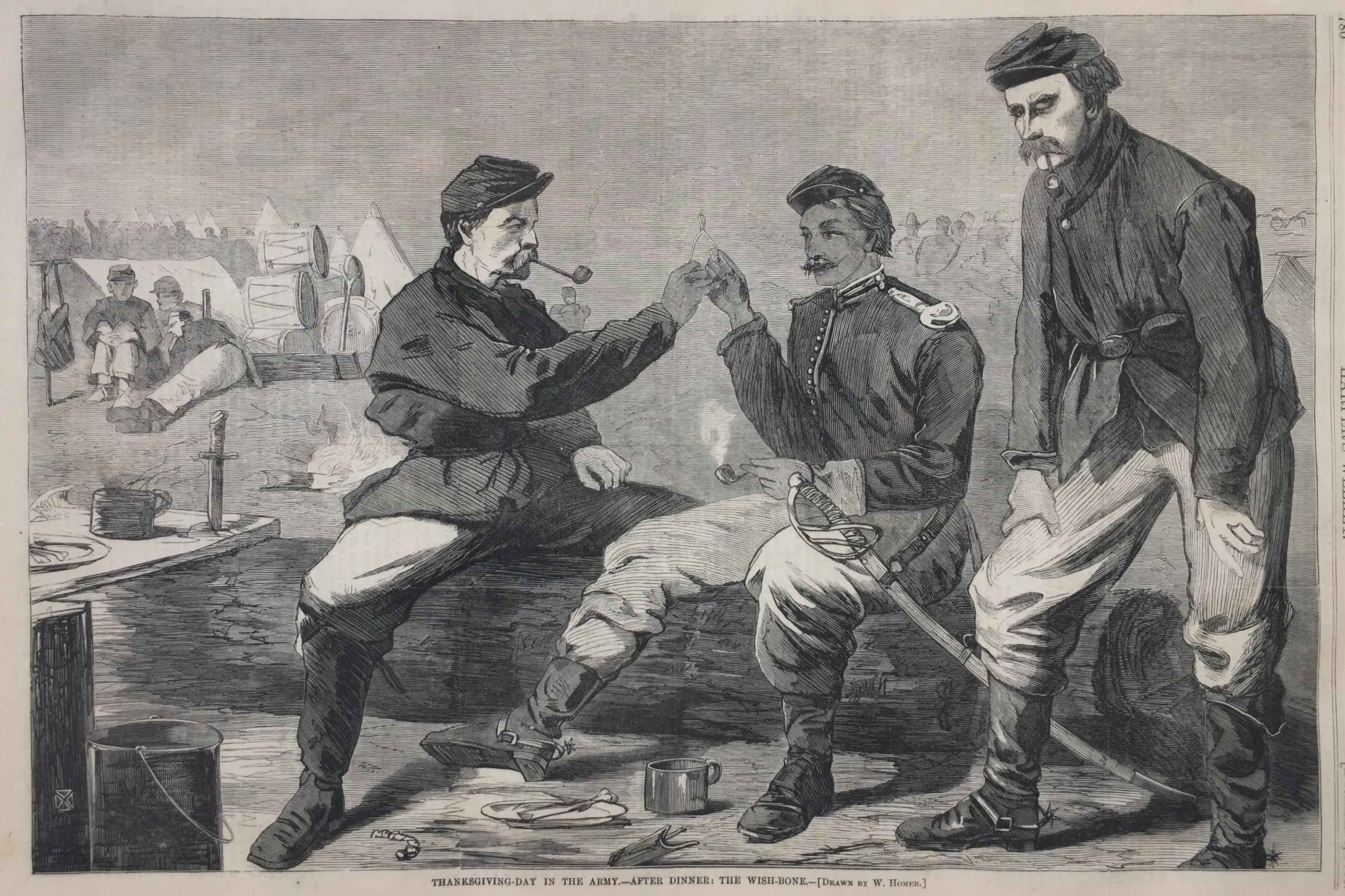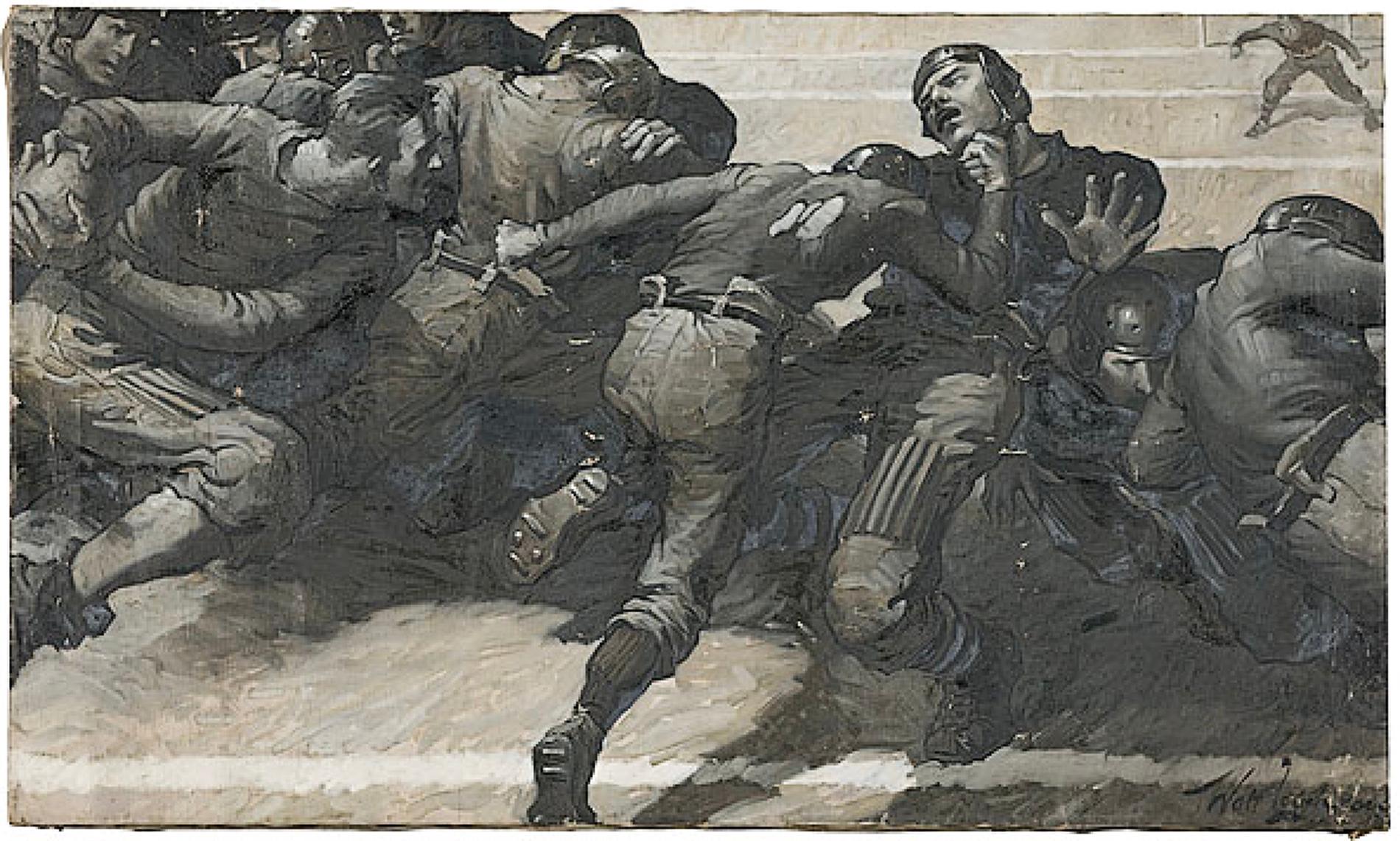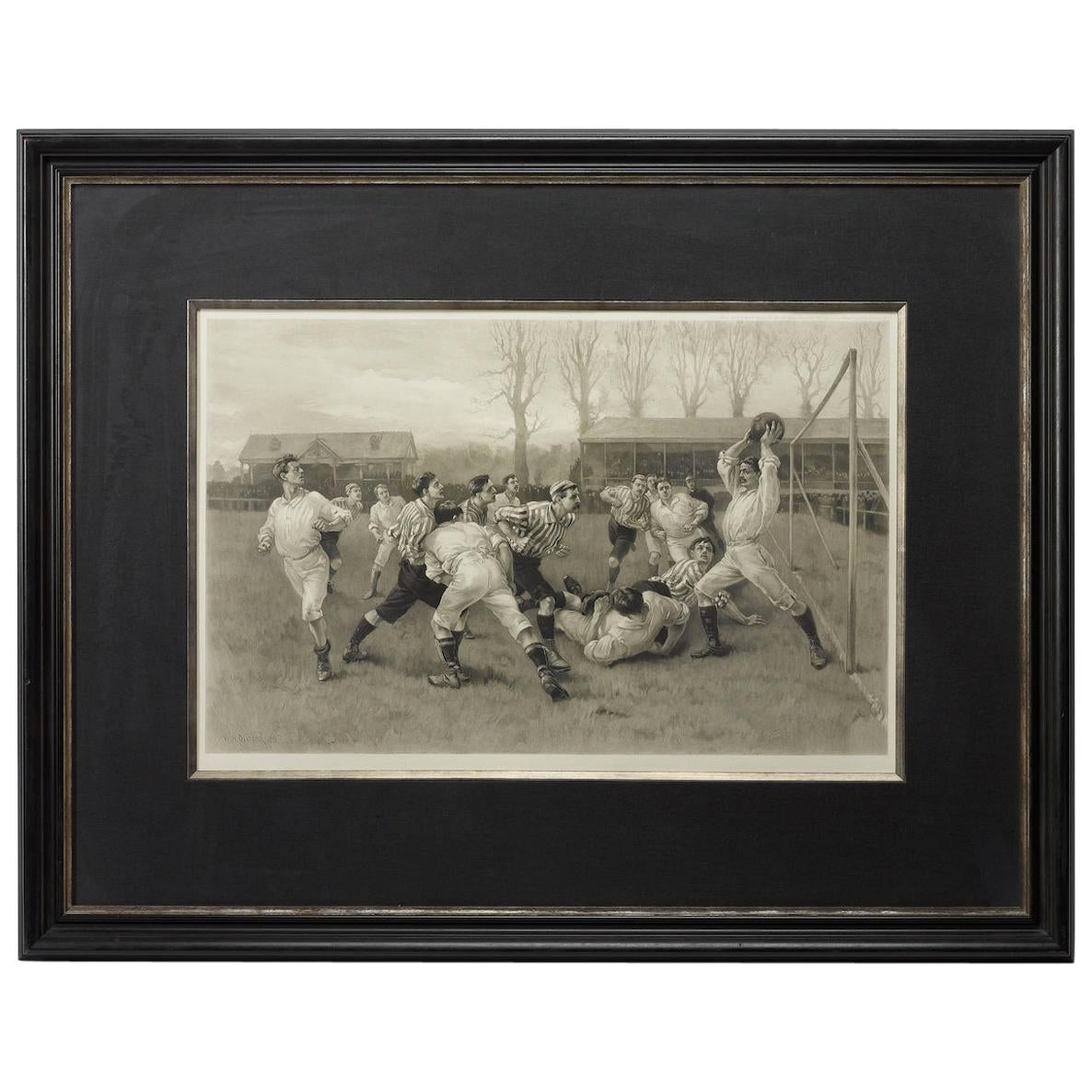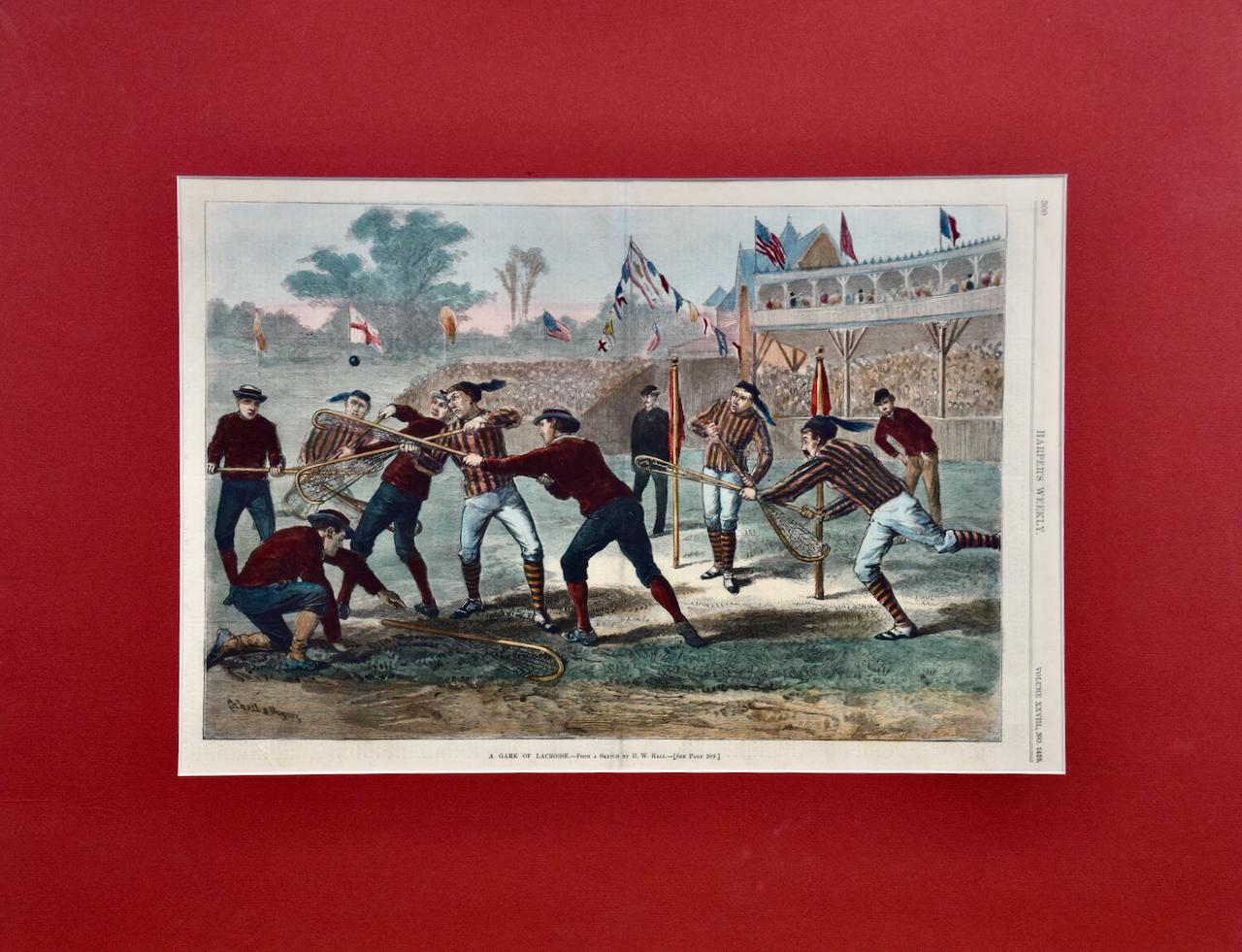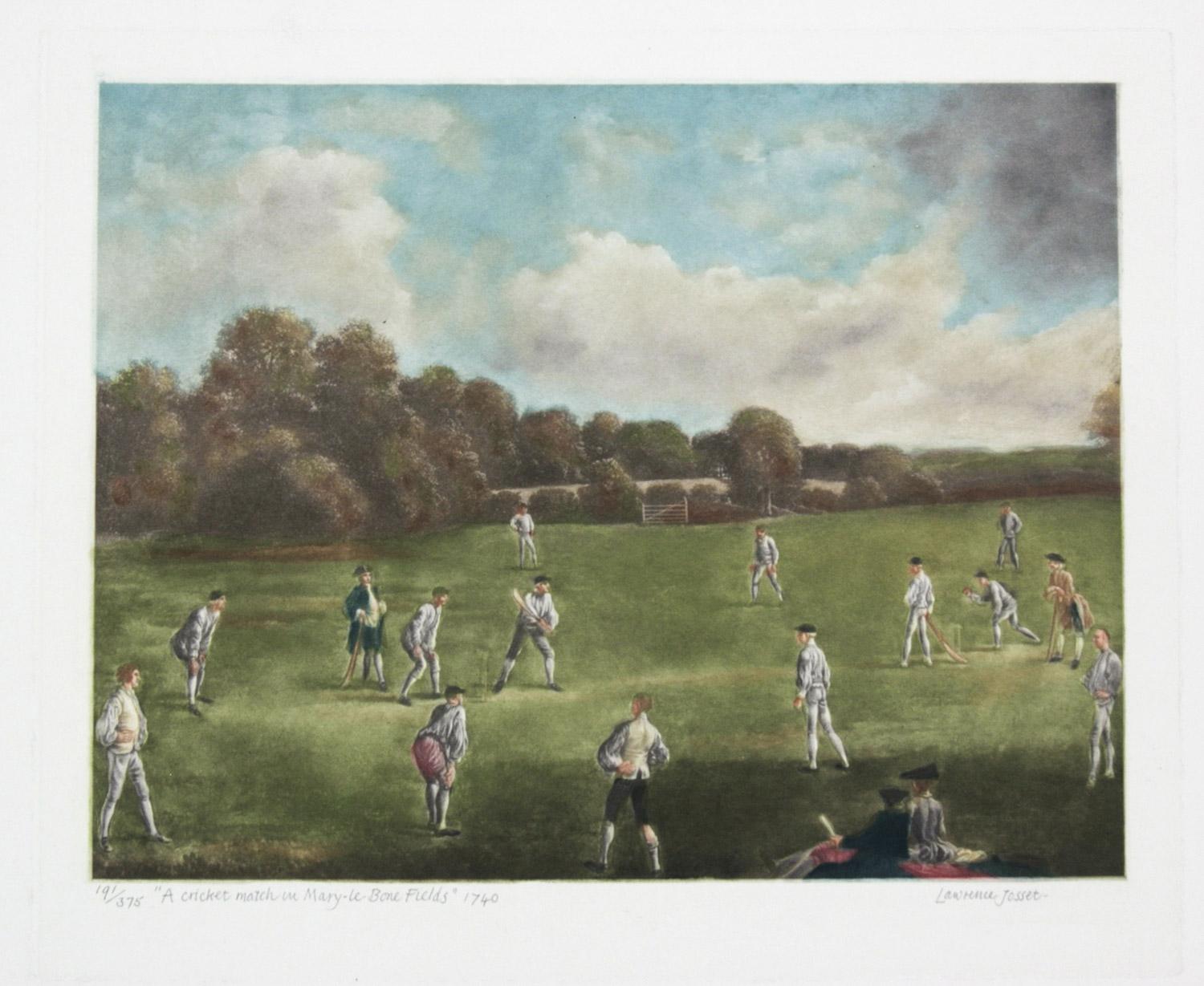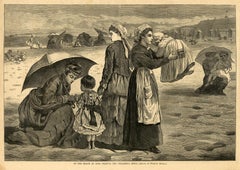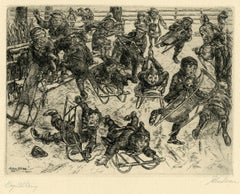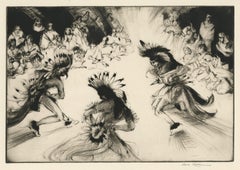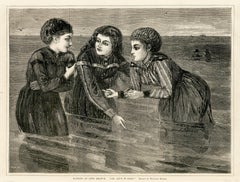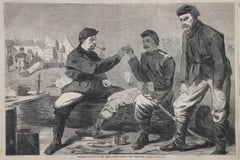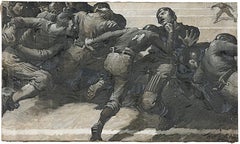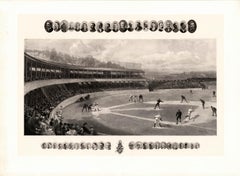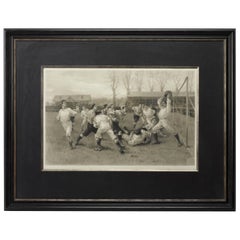Items Similar to Holiday in Camp -- Soldiers Playing "Foot-Ball"
Want more images or videos?
Request additional images or videos from the seller
1 of 7
Holiday in Camp -- Soldiers Playing "Foot-Ball"1865
1865
$325
£246.25
€282.55
CA$457.33
A$502.73
CHF 264.21
MX$6,104.96
NOK 3,295.97
SEK 3,122.70
DKK 2,108.75
About the Item
Holiday in Camp -- Soldiers Playing "Foot-Ball"
Wood engraving, 1865
After Winslow Homer
Unsigned
(Signed in text in title caption, see photo)
Published in Harper's Weekly July 15, 1865
A very rare early image of men playing football. Note the round ball.
Condition: Usual vintage condition with folds, creases, small tears in the sheet edge and very small stains.
Tears into image bottom left. Common with Harper's Weekly engravings due to the fragile newsprint that was used and the 150 plus years of aging.
Image size: 9 1/4 x 13 3/4 inches
"Winslow Homer’s wood engravings resulted from a collaborative process that involved many hands and transformed his designs into metal (electrotype) printing plates. To begin, Homer usually drew on a prepared, end-grain boxwood block—most often consisting of smaller pieces of wood bolted together. A team of professional wood engravers then incised the blocks.
Next, pictorial and text components were arranged into a page layout and a wax mold was made of the whole. This mold was coated with powdered graphite and placed in an electrically charged chemical bath together with plates of copper. The chemicals and electric current caused copper particles to form on the graphite coating, creating a precise metal replica of the page’s type and engraved images. This replica, reinforced with various metals, was then used to print the images we call wood engravings."
Courtesy: The Clark Museum
Winslow Homer (1836-1910)
"Winslow Homer (1836-1910) was an American landscape, marine and genre artist. A master of oil painting and watercolor, he was also a gifted printmaker, illustrator and pictorial journalist. Born in Boston, the artist received no real formal training with the exception of some life-drawing classes at the National Gallery of Design and a stint studying painting with Frédéric Rondel in 1861. From 1859 until the mid-1870s, Homer worked as a commercial illustrator. During the Civil War, the artist gained international public recognition for his pictorial documentation of the battlefield commissioned by Harper's Weekly.
Post-war, Homer traveled first to Europe then returned to the States to establish a studio in New York City. There he began executing illustrations depicting vignettes from everyday life. The public embraced the authenticity of these portrayals as embodying the democratic spirit, considering them a visual similarity to the poetry of Walt Whitman at that time. Although popular and successful, in 1876 Homer abandoned commercial work, devoting attention to painting his vision of the American scene full-time.
Homer's subject matter included landscape and rural genre scenes, but he also found inspiration in the sea and traveled extensively to coastal locations - England, Cuba, the Caribbean, the Bahamas, Florida and Prouts Neck, Maine where he eventually would live out his life. His dramatic and forceful renderings of the Atlantic seascape remain unsurpassed and some of his most celebrated paintings. The Adirondack Mountains were an additional important destination. For 35 years the artist found inspiration for his work in the rugged terrain, the life of the outdoorsman and the natural beauty of the region.
In the last fifteen years of his life, Homer was revered as the nation's foremost painter. At the time of his death, Homer's work was represented in more public collections than any other living American artist. Considered by many to be 19th century America's most gifted artist, Homer's works are often viewed as embodying the beginnings of a truly "national" art that adopted the American experience as its subject matter. His ability to capture the spirit of America through images characterized by their directness, realism, subjectivity and color, resonate with the nation and hold a special position in the history of American art."
Courtesy: The Hyde Collection Museum, Glens Falls, NY
- Creation Year:1865
- Dimensions:Height: 9.25 in (23.5 cm)Width: 13.75 in (34.93 cm)
- Medium:
- Movement & Style:
- After:Winslow Homer (1836 - 1910, American)
- Period:
- Condition:
- Gallery Location:Fairlawn, OH
- Reference Number:Seller: FA105811stDibs: LU14015203742
About the Seller
5.0
Recognized Seller
These prestigious sellers are industry leaders and represent the highest echelon for item quality and design.
Platinum Seller
Premium sellers with a 4.7+ rating and 24-hour response times
Established in 1978
1stDibs seller since 2013
813 sales on 1stDibs
Typical response time: <1 hour
Associations
International Fine Print Dealers Association
- ShippingRetrieving quote...Shipping from: Fairlawn, OH
- Return Policy
Authenticity Guarantee
In the unlikely event there’s an issue with an item’s authenticity, contact us within 1 year for a full refund. DetailsMoney-Back Guarantee
If your item is not as described, is damaged in transit, or does not arrive, contact us within 7 days for a full refund. Details24-Hour Cancellation
You have a 24-hour grace period in which to reconsider your purchase, with no questions asked.Vetted Professional Sellers
Our world-class sellers must adhere to strict standards for service and quality, maintaining the integrity of our listings.Price-Match Guarantee
If you find that a seller listed the same item for a lower price elsewhere, we’ll match it.Trusted Global Delivery
Our best-in-class carrier network provides specialized shipping options worldwide, including custom delivery.More From This Seller
View AllOn the Beach at Long Branch - The Children's Hour
By Winslow Homer
Located in Fairlawn, OH
On the Beach at Long Branch - The Children's Hour
Wood engraving, 1874
Published in "Harper's Weekly" August 15, 1874 (p. 672)
Image size: 9 1/4 x 13 5/8 inches
Provenance: Wunderlic...
Category
1870s Hudson River School Figurative Prints
Materials
Woodcut
Boys Sledding
By John Sloan
Located in Fairlawn, OH
Boys Sledding
Etching, 1920
Signed and titled in pencil by the artist below image (see photos)
Annotated in pencil by the artist "100 proofs"
Signed and dated in the plate lower left...
Category
1920s Ashcan School Prints and Multiples
Materials
Etching
Indian Friendship Dance
By Gene Kloss
Located in Fairlawn, OH
Indian Friendship Dance
Drypoint, 1953
Signed in pencil lower right, (see photo)
Edition 200
Published by The Society of American Graphic Artists, New York
An impression is in the collection of SAAM, Washington and RISD Museum,
Condition: Excellent
Very rich impression with burr and selective whiping of the ink for atmospheric nocturnal effect.
Image/Plate size: 8 3/16 x 11 15/16 inches
Sheet size: 11 1/8 x 17 inches
Reference: Kloss 450
"'Indian Friendship Dance' is an eloquent statement of something which Gene Kloss has both observed and participated in. It is an Indian dance that is thought of as entertainment, rather than ceremony, but it is essentially an idea expressed in action, and an idea that has universal meaning. The young men who dance wear costumes of exquisite workmanship, intricately wrought with beads and feathers and subtle combinations of colors. The dancers are trained from childhood but develop their own steps and exhibit distinctive strength and grace. Singers and a tom-tom accompany the dance and since it usually takes place at night, a campfire is the source of light. The conclusion occurs when all the onlookers, old and young and from many places, join hands with the dancers in a slow revolving movement, while those who can, sing the difficult but meaningful Indian song that flows with the rhythmical dance step and speaks of fellowship, brotherhood, friendship." - An excerpt from a descriptive statement, written by Lynd Ward, and distributed with the drypoint at the time of publication." Courtesy Old Print Shop
Born Alice Glasier in Oakland, CA, Kloss grew up amid the worldly bustle of the San Francisco Bay Area. She attended the University of California at Berkeley, graduating with honors in art in 1924. She discovered her talents in intaglio printmaking during a senior-year course in figurative drawing. The professor, Perham Nahl, held up a print from Kloss’ first plate, still damp from the printing process, and announced that she was destined to become a printmaker.
In 1925, Gene married Phillips Kloss, a poet and composer who became her creative partner for life. The match was uncanny, for in her own way Gene, too, was a poet and a composer. Like poetry, her artworks capture a moment in time; like music, her compositions sing with aesthetic harmony. Although she was largely self-taught, Kloss was a printmaking virtuoso.
On their honeymoon the Klosses traveled east from California, camping along the way. They spent two week is Taos Canyon – with a portable printing press cemented to a rock near their campsite – where Gene learned to appreciate the wealth of artistic subject matter in New Mexico. The landscape, the cultures, and the immense sky left an indelible impression on the couple, who returned every summer until they made Taos their permanent home 20 years later.
Throughout her life, Kloss etched more than 625 copper plates, producing editions ranging from five to 250 prints. She pulled every print in every edition herself, manually cranking the wheel of her geared Sturges press until she finally purchased a motorized one when she was in her 70s. Believing that subject matter dictated technique, she employed etching, drypoint, aquatint, mezzotint, roulette, softground, and a variety of experimental approaches, often combining several techniques on the same plate. She also produced both oil and watercolor paintings.
Kloss’ artworks are filled with drama. Her prints employ striking contrasts of darkness and light, and her subjects are often illuminated by mysterious light sources. Though she was a devout realist, there is also a devout abstraction on Kloss’ work that adds an almost mythical quality.
For six decades Kloss documented the cultures of the region-from images of daily life to those of rarely seen ceremonies. She and her husband shared a profound respect for the land and people, which made them welcome among the Native American and Hispanic communities. Kloss never owned a camera but relied instead on observation and recollection. Her works provide an inside look at the cultures she depicted yet at the same time communicate the awe and freshness of an outsider’s perspective.
Although Kloss is best known for her images of Native American and Penitente scenes, she found artistic inspiration wherever she was. During the early years of their marriage, when she and Phil returned to the Bay Area each winter to care for their aging families, she created images of the California coast. And when the Klosses moved to southwestern Colorado in 1965, she etched the mining towns and mountainous landscapes around her.
In 1970 the Klosses returned to Taos and built a house north of town. Though her artwork continued to grow in popularity, she remained faithful to Taos’ Gallery A, where she insisted that owner Mary Sanchez keep the prices of her work reasonable regardless of its market value. Kloss continued to etch until 1985, when declining health made printmaking too difficult.
From her first exhibition at San Francisco’s exclusive Gump’s in 1937 to her 1972 election to full membership in the National Academy of Design, Kloss experienced a selective fame. She received numerous awards, and though she is not as well known as members of the Taos Society of Artists...
Category
1950s American Realist Figurative Prints
Materials
Drypoint
Bathing at Long Branch-“Oh, Ain’t it Cold”
By Winslow Homer
Located in Fairlawn, OH
Bathing at Long Branch-“Oh, Ain’t it Cold”
Wood engraving, 1871
Signed in the block with the artist's initials "WH", see photo
Published in: Every Saturday, Aug. 16, 1871
Condition: ...
Category
1870s Hudson River School Figurative Prints
Materials
Woodcut
St. Valentine's Day -- The Old Story in All Lands
By Winslow Homer
Located in Fairlawn, OH
St. Valentine's Day -- The Old Story in All Lands
Wood engraving, 1868
Published in: Harper's Weekly, February 22, 1868
Titled and signed in the block
Image size: 13 5/8 x 9 inches
C...
Category
1860s Hudson River School Figurative Prints
Materials
Engraving
Lice
Located in Fairlawn, OH
Lice (Mallards grooming themselves)
Drypoint, 1927
Signed and dated lower right (see photo)
Titled lower left corner
Condition: Excellent
Image/Plate size: 6 7/8 x 10 3/4 inches
Shee...
Category
1920s American Realist Animal Prints
Materials
Drypoint
You May Also Like
THANKSGIVING IN CAMP
By Winslow Homer
Located in Santa Monica, CA
AFTER - WINSLOW HOMER (1836-1910)
THANKSGIVING IN THE ARMY - After Dinner: the Wishbone, 1864
Original wood engraving as published by Harpers Weekly December 3, 1864, after a drawing by Winslow Homer. Image 9 3/4" x 14, Sheet 10 3.\/4 x 15 3/4" . Generally good condition, a small stain in the upper right margin.
Homer contributed drawings to Harper's Weekly from 1857 to 1875. They were converted to wood engravings by Harper's craftsman and published in Harper's Weekly. Although after his original drawings, they are now accepted as an important part of his body of work by museums and collectors. They were very large editions. As such, they occur often in the marketplace. Harper's published during the Civil War years as this was, were widely read and kept as people followed the war first hand and its aftermath over the years continuing today as both Homer and Civil War collectables
Category
1860s American Realist Figurative Prints
Materials
Woodcut
$175 Sale Price
53% Off
Old Time Football in the 1920s - Football 1920s - Classic Football
By Walt Louderback
Located in Miami, FL
You Got to be a Football Hero to Get Along with a Beautiful Girl. Masterfully composed and dynamic illustration that show a player getting punched in the jaw. During this period, there were no face...
Category
1920s Academic Figurative Paintings
Materials
Canvas, Oil
A Base Ball Game
By Henry Sandham
Located in New York, NY
Goupilgravure (photogravure) was printed in Paris and published April 1, 1896, by Boussod Valadon & Co. Successors to Goupil & Co. Painted by Henry Sandham, 1894. "A BASEBALL GAME" depicts the 1894 "Temple Cup" game between the Baltimore Orioles and the New York Giants...
Category
Late 19th Century Naturalistic Figurative Prints
Materials
Photogravure
1891 Football Match and Association Game after W. Overend, Antique Photogravure
Located in Colorado Springs, CO
This wonderfully expressive photogravure was published in 1891 in London. The etching was made after W.H. Overend’s original work, still showcasing his signature at the bottom left o...
Category
Antique 1890s English Prints
Materials
Paper
"A Game of Lacrosse": A Hand-colored 19th Century Woodcut Engraving by Hall
Located in Alamo, CA
A colorful and attractive hand-colored 19th century woodcut engraving entitled "A Game of Lacrosse" after a drawing by W. H. Hall. It was published in New York in Harper's Weekly on May 10, 1884. It depicts a scene from an intense lacrosse game.
This hand-colored woodcut engraving is presented in a red mat that measures 16" high x 20.63" wide. The sheet measures 10.63" high x 15.88" wide. There is a central fold, as issued. The print is in excellent condition.
Lacrosse is the oldest sport in North America, possibly originating as far back as the 1400's. The sport was first invented by Native Americans, who originally played it as a means to toughen braves for war or to settle tribal disputes. It was played by between 100 and 1,000 participants at a time. There were no strict boundaries and the game could cover miles and take days to complete. It was very violent with many injuries, which were sometimes fatal. The game was unknown to whites until the 17th century when a Jesuit priest observed Heron Indians playing it. He thought the stick and netting resembled the "crosier" carried by bishops during religious ceremonies, This led to the name "la crosse".
A Canadian dentist standardized the rules of the game in 1867 and the 1st college team was created at New York University in 1877. The game gained national attention and popularity in 1956 when the Hall-of-Fame football player Jim Brown...
Category
1880s Landscape Prints
Materials
Woodcut
A Cricket Match at Mary-le-Bone Fields by Lawrence Josset
Located in Paonia, CO
Lawrence Jossett ( 1910 – 1995 ) was born in Cambridgeshire England. He acquired his knowledge and skill as an engraver of bank notes. His natural talent and his attention to detail ...
Category
20th Century Figurative Prints
Materials
Mezzotint
More Ways To Browse
Antique Ball
Antique Soldiers
Antique Holiday
Antique Football
Max Beckmann Drypoint
May Belfort
Melanie Taylor Kent
Mexican Revolution Art
Michel Delacroix On Sale
Munch Poster 1969
Naoko Matsubara
Nude At The Window Dali
Nursery Rhyme Prints Vintage
Oil Paintings From 1964
Opie Lenticular
Original Pears Prints Antique
Pablo Picasso Sculpteur
Paris Street Scenes Prints
